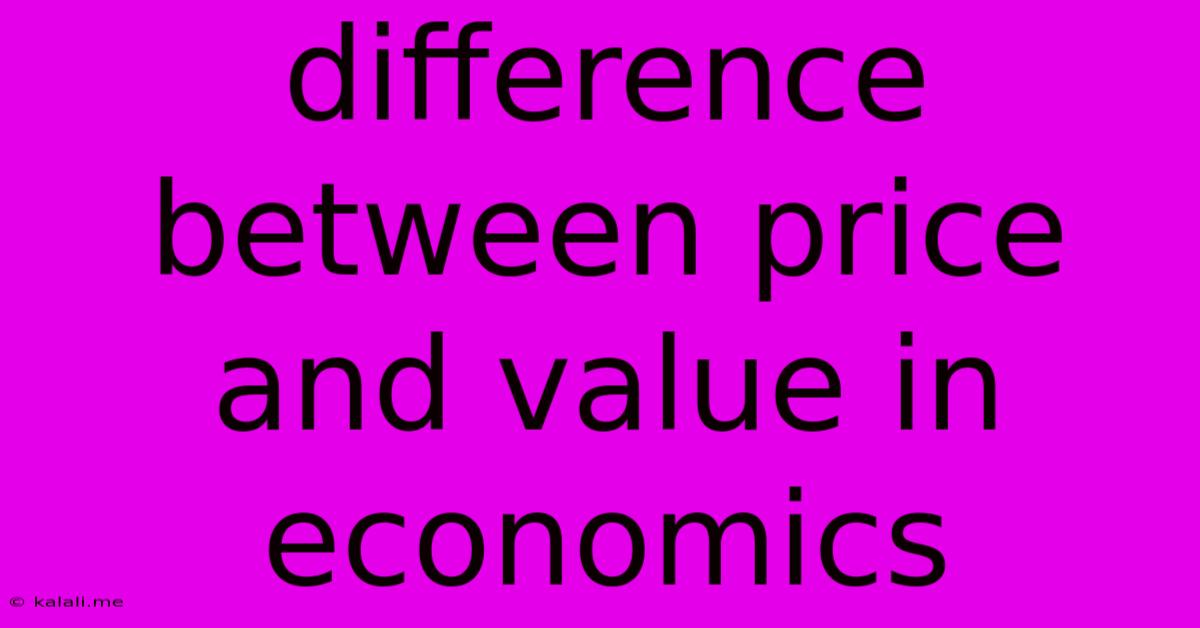Difference Between Price And Value In Economics
Kalali
Jun 15, 2025 · 3 min read

Table of Contents
The Difference Between Price and Value in Economics: Understanding the Core Concepts
Meta Description: This article explores the fundamental difference between price and value in economics, clarifying the concepts of market price, perceived value, and the factors influencing both. Learn how understanding this distinction is crucial for consumers and businesses alike.
In the realm of economics, the terms "price" and "value" are often used interchangeably, leading to confusion. However, a clear understanding of the distinction between these two concepts is crucial for both consumers making purchasing decisions and businesses setting pricing strategies. While seemingly similar, price and value represent distinct economic forces that interact to shape market dynamics.
Price: The Monetary Exchange
Price, simply put, is the monetary amount exchanged for a good or service. It's the readily observable figure – the number on the price tag, the amount listed on an invoice, or the figure quoted by a vendor. Price is determined by various market forces, including supply and demand, competition, production costs, and government regulations (like taxes). It's a concrete, objective measurement. Think of the price of a cup of coffee – it's the dollar amount you pay at the cafe.
Value: The Subjective Perception
Value, on the other hand, is a far more subjective concept. It represents the perceived worth or usefulness of a good or service to a particular individual or group. This worth isn't necessarily linked directly to the monetary price. Value is influenced by a range of factors including:
- Utility: How useful or satisfying is the good or service to the consumer? A life-saving medicine, for example, holds immense value regardless of its price.
- Scarcity: The limited availability of a good or service can significantly increase its perceived value. Rare collectibles or limited-edition items are prime examples.
- Personal Preferences: Individual tastes and preferences play a crucial role in determining value. What one person considers valuable, another might deem worthless.
- Brand Perception: Brand reputation and image significantly influence the perceived value of a product. A luxury brand often commands a higher price because of its associated value.
- Social Status: The social standing associated with owning a particular good or service can enhance its perceived value.
The Interplay of Price and Value
The relationship between price and value is complex and dynamic. Ideally, a product's price should reflect its value to the consumer. If the price is significantly higher than the perceived value, consumers are less likely to purchase it. Conversely, if the price is significantly lower than the perceived value, demand will likely increase. This interplay is what drives market equilibrium.
However, this ideal isn't always achieved. Marketing and advertising play a crucial role in influencing perceived value, sometimes creating a disconnect between price and true utility. Companies might leverage branding and emotional appeal to increase perceived value and justify a higher price. This is why understanding the difference between price and value is so vital for making informed purchasing decisions.
Examples Illustrating the Difference
Consider these scenarios:
- A diamond ring: The price of a diamond ring can be extremely high, driven by its rarity and social symbolism. However, its actual value in terms of utility (a simple band could serve the same function) may be considerably lower for many people.
- A generic painkiller vs. a name-brand version: Both offer the same basic utility (pain relief), yet the name-brand version often commands a much higher price due to branding and perceived quality.
- A vintage car: The price of a classic car may far exceed its functional value as transportation. Its value is primarily driven by its rarity, historical significance, and collector appeal.
In conclusion, while price is a quantifiable monetary amount, value is a subjective assessment of worth. Understanding this fundamental distinction is key to making smart economic decisions, whether as a consumer or a business. Recognizing the factors influencing both price and value enables individuals to make better choices and businesses to develop effective pricing strategies.
Latest Posts
Latest Posts
-
What Is Prime Factorization Of 180
Jun 15, 2025
-
Which Of The Following Statements Are True About Viruses
Jun 15, 2025
-
What Is The Major Product Of The Following Reaction Hbr
Jun 15, 2025
-
Is Milk Of Magnesia An Acid Or Base
Jun 15, 2025
-
How Many Teaspoons Are Equivalent To 44 Tablespoons
Jun 15, 2025
Related Post
Thank you for visiting our website which covers about Difference Between Price And Value In Economics . We hope the information provided has been useful to you. Feel free to contact us if you have any questions or need further assistance. See you next time and don't miss to bookmark.